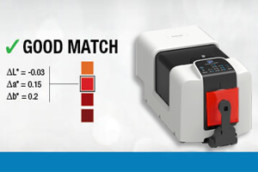How To Formulate Color – Top Tips
In addition, you must use precise color measurement instrumentation and sophisticated machinery to get the color correct the first time.
Evaluation Best Practices to Match Color Standards
- Preparation is key – Before starting the color formulation process, the following color measurement and visual evaluation conditions should be defined:
- Instrument model, type, and geometry
- Standard illuminants
- Standard observer
- Viewing angle
- Color space
- Color difference formula
- Color tolerance values
- Sample preparation and presentation methods
- Light sources for visual evaluations
- Consistent recipe – Ideally, the same color formula that was used to create the standard should be used when formulating the color of a product. This, however, is often not possible. A color formulation process should be defined to create a color recipe that matches the standard the first time or with minimal waste and time.
- Agree standards – A standard color should first be defined internally or between supplier and customer. Using color measurement instrumentation specific to your application needs, measure the color you would like to match for the finished product and record its color values
- Make notes – Upload the standard’s color values to color formulation software to calculate the recipe that best matches the standard
- Create a sample – From the recipe calculated in the software, create a small batch of this color. After preparing and, if needed, conditioning the sample in a standardized process, measure it using a spectrophotometer to compare its color values and reflectance curve to the standard
- Consider the impact of lighting – Visually compare the sample against the standard within the controlled environment of a light booth to see if there are any noticeable inconsistencies. Samples should be compared under at least three different light sources to get the most accurate results and identify metamerism
- Save the recipe – Save the ideal recipe in the color formulation software to recall and reproduce in future batches. The software may calculate a few different recipes meeting different criteria, you will want to make sure you’re saving the best version for your purposes.
- Consider the test conditions – as well as the procedures being used standardizing the formulation conditions also helps to maintain consistency. Part of this is maintaining equipment and defining conditions that will impact the color results. This includes:
- Maintain formulation equipment to ensure it is in proper working order
- Monitor strength of incoming dyes or pigments to ensure consistency is maintained
- Establish accurate weighing methods for substrates, dyes, pigments, or auxiliaries based on the weight of the objects being colored
- Calibrate weighing scales and color measurement instrumentation at scheduled times to maintain accuracy and optimum performance
- Maintain the light booth used during visual evaluations by replacing the lamps as recommended by the lamp supplier
- Set a fixed room temperature so as not to cause a drift in the color of your samples
- Standardize procedures from beginning to end, including the creation of samples for measurement, mixing samples, flash time after mixture, oven temperature for drying, and drying time, so as not to impact the final color
By standardizing the color formulation process and establishing a controlled environment, users can carry out color matching more effectively with minimal waste and time spent. To formulate and control the color of your samples more efficiently, the following products are recommended:
- SpectraMagic™ NX2 Color Data Software Software >
- CM-3700A Plus Bench-top Spectrophotometer >
- CM-36dG Bench-top Spectrophotometer>
- CM-5 Bench-top Spectrophotometer >
- MM-4e Light Booth >
The technological leader in color and light measurement solutions, Konica Minolta Sensing Americas helps organizations formulate, evaluate, and control color to meet product quality and operational goals more efficiently.










